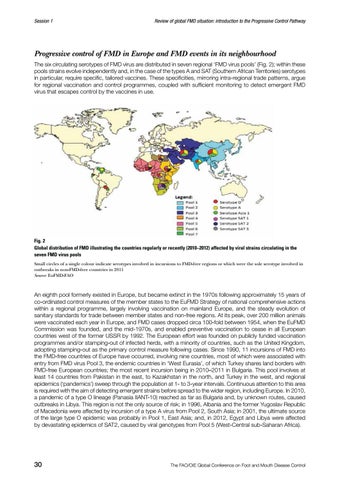Session 1
Review of global FMD situation: introduction to the Progressive Control Pathway
Progressive control of FMD in Europe and FMD events in its neighbourhood The six circulating serotypes of FMD virus are distributed in seven regional ‘FMD virus pools’ (Fig. 2); within these pools strains evolve independently and, in the case of the types A and SAT (Southern African Territories) serotypes in particular, require specific, tailored vaccines. These specificities, mirroring intra-regional trade patterns, argue for regional vaccination and control programmes, coupled with sufficient monitoring to detect emergent FMD virus that escapes control by the vaccines in use.
Fig. 2 Global distribution of FMD illustrating the countries regularly or recently (2010–2012) affected by viral strains circulating in the seven FMD virus pools Small circles of a single colour indicate serotypes involved in incursions to FMD-free regions or which were the sole serotype involved in outbreaks in non-FMD-free countries in 2011 Source: EuFMD-FAO
An eighth pool formerly existed in Europe, but became extinct in the 1970s following approximately 15 years of co-ordinated control measures of the member states to the EuFMD Strategy of national comprehensive actions within a regional programme, largely involving vaccination on mainland Europe, and the steady evolution of sanitary standards for trade between member states and non-free regions. At its peak, over 200 million animals were vaccinated each year in Europe, and FMD cases dropped circa 100-fold between 1954, when the EuFMD Commission was founded, and the mid-1970s, and enabled preventive vaccination to cease in all European countries west of the former USSR by 1992. The European effort was founded on publicly funded vaccination programmes and/or stamping-out of infected herds, with a minority of countries, such as the United Kingdom, adopting stamping-out as the primary control measure following cases. Since 1990, 11 incursions of FMD into the FMD-free countries of Europe have occurred, involving nine countries, most of which were associated with entry from FMD virus Pool 3, the endemic countries in ‘West Eurasia’, of which Turkey shares land borders with FMD-free European countries; the most recent incursion being in 2010–2011 in Bulgaria. This pool involves at least 14 countries from Pakistan in the east, to Kazakhstan in the north, and Turkey in the west, and regional epidemics (‘pandemics’) sweep through the population at 1- to 3-year intervals. Continuous attention to this area is required with the aim of detecting emergent strains before spread to the wider region, including Europe. In 2010, a pandemic of a type O lineage (Panasia IIANT-10) reached as far as Bulgaria and, by unknown routes, caused outbreaks in Libya. This region is not the only source of risk; in 1996, Albania and the former Yugoslav Republic of Macedonia were affected by incursion of a type A virus from Pool 2, South Asia; in 2001, the ultimate source of the large type O epidemic was probably in Pool 1, East Asia; and, in 2012, Egypt and Libya were affected by devastating epidemics of SAT2, caused by viral genotypes from Pool 5 (West-Central sub-Saharan Africa).
30
The FAO/OIE Global Conference on Foot and Mouth Disease Control
















